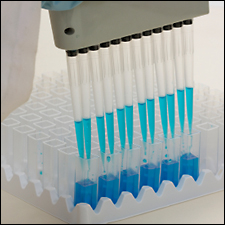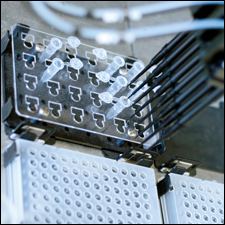 |
|
Questions and Answers about ICCVAMInteragency Coordinating Committee on the Validation of Alternative Methods
New Alternatives to Animal Testing
Stakeholders, Nominations and Outreach
Progress, Plans, Reports and Outreach
Interagency Coordinating Committee on the Validation of Alternative MethodsWhat does ICCVAM stand for?ICCVAM (pronounced "ICK-VAM") is an acronym that refers to the Interagency Coordinating Committee on the Validation of Alternative Methods. ICCVAM is made up of representatives from 15 Federal agencies that generate or use toxicological data to carry out their responsibilities to protect and advance the health and safety of people, animals, and the environment. What agencies are represented on ICCVAM?Consumer Product Safety Commission (CPSC) (http://cpsc.gov/) What is ICCVAM’s Mission?ICCVAM's mission is to promote the development, validation, and regulatory acceptance of new, revised, and alternative regulatory safety testing methods. Emphasis is on alternative methods that will reduce, refine (less pain and distress), and replace the use of animals in testing while maintaining and promoting scientific quality and the protection of human health, animal health, and the environment.
To accomplish this, ICCVAM is charged with the following functions:
What is NICEATM?NICEATM (pronounced "NIGH-SEA-TUM") stands for the National Toxicology Program (NTP) Interagency Center for the Evaluation of Alternative Toxicological Methods). NICEATM is part of the National Institute of Environmental Health Sciences (NIEHS) located in Research Triangle Park, NC. What does NICEATM do?
NICEATM administers and provides scientific support for ICCVAM, by
What is the relationship between NICEATM and ICCVAM?ICCVAM is an interagency committee that meets several times a year. ICCVAM does not conduct validation studies. NICEATM is an office within the National Toxicology Program (NTP) at the National Institute of Environmental Health Sciences with dedicated staff and contractor support. NICEATM provides assistance and coordinates the activities that ICCVAM requires to evaluate and make recommendations regarding new, revised, and alternative test methods. What is the role of NICEATM and ICCVAM in gaining regulatory acceptance of new and alternative test methods?NICEATM and ICCVAM assess the validation status of new, revised and alternative safety testing methods to determine their usefulness and limitations for testing purposes. ICCVAM then transmits recommendations to Federal agencies regarding appropriate uses of these methods based on their scientific validity. Each Federal agency then determines whether the test methods are acceptable for their respective programs. Agencies must respond to ICCVAM recommendations within 180 days after receiving them. New Alternatives to Animal TestingWhat are alternative toxicity test methods?Alternative toxicity test methods are test methods that, reduce, refine or replace animal use in regulatory toxicity testing. Reduction, refinement, and replacement are commonly referred to as “the 3Rs of alternatives”. The 3Rs concept was first described by William Russell and Rex Burch in their book, The Principles of Humane Experimental Technique, published in 1959. What does "refine, reduce, or replace" or the "3Rs," mean in terms of animal use for regulatory toxicity testing?
Why are animals still used for safety testing?
Consumer products, medicines, and industrial and agricultural chemicals must be adequately tested in order to identify potential health and safety hazards. U.S. regulatory agencies that require or use toxicity test data are responsible for protecting human and animal health and the environment. To carry out this mission, agencies require that all toxicity test methods used for regulatory purposes are based on sound science and are able to adequately identify hazards. Human and animal responses to toxicants are complex, and difficult to accurately assess using only in vitro systems or computer models. The term in vitro refers to experiments performed in laboratory containers, such as test tubes or petri dishes,with living tissues, organs, or cells obtained from animals or people. No single in vitro test method is currently available to serve all regulatory needs for a specific testing area. Rather, integrated approaches using alternative test methods, conventional animal testing, and other information about the properties of a test substance are used to accurately assess hazards. Are scientists required to consider alternative methods before they use animals for testing?Yes, U.S. laws require that alternatives must be considered before using animals for research and testing. These laws are based on the U.S. Government Principles for the Utilization and Care of Vertebrate Animals Used in Testing, Research, and Training, which are incorporated in the Public Health Service Policy on Humane Care and Use of Laboratory Animals. Institutional Animal Care and Use Committees must approve proposed animal use, and ensure that alternatives are being used where appropriate. Are Federal agencies that use toxicity data required to support the development of alternative test methods?Yes. The U.S. National Institutes of Health (NIH) Revitalization Act of 19931 directed NIH to support research to reduce, refine, and replace animal use in biomedical research, and to develop and validate methods that will reduce and replace animals in acute and chronic safety testing. The ICCVAM Authorization Act of 20002, created the Interagency Coordinating Committee on the Validation of Alternative Methods (ICCVAM) as a permanent interagency committee to facilitate alternative test method development, validation, and regulatory acceptance. . 1. Public Law 103-43 What will ICCVAM do to promote the use of alternative test methods?NICEATM and ICCVAM will provide high quality comprehensive test method background review documents and the results of independent scientific peer reviews to support the approval of new, revised, and alternative test methods by regulatory agencies and the international community. Once an alternative test method has been accepted, ICCVAM will work to promote the use of the test method by sponsoring and participating in training workshops and scientific meetings to reach interested stakeholders who may want to use or consider data from the test method. Stakeholders, Nominations and OutreachWho are ICCVAM's stakeholders?ICCVAM's stakeholders are any person or organization that uses, develops or has an interest in toxicological test methods or the data that is generated from toxicological testing. They include:
How does ICCVAM communicate with its stakeholders?ICCVAM announces activities and requests input from its stakeholders by publication of notices in the Federal Register, posting announcements on its website (http://iccvam.niehs.nih.gov/) and sending emails to members of the ICCVAM-all listserv mailing list. ICCVAM also actively participates in national and international meetings by presenting results from their many different review activities. Who can make test method nominations and submissions?NICEATM and ICCVAM welcome nominations of relevant new, revised, and alternative test methods from any of its stakeholders, including government agencies, academics, companies developing new test methods, and animal welfare organizations. Test method sponsors are encouraged to consult with NICEATM and ICCVAM throughout the test method research, development, translation, and validation process, as well as during preparation of submissions. How does ICCVAM prioritize test method evaluations?A sponsor or nominator submits a test method for evaluation to NICEATM following ICCVAM submission guidelines (http://iccvam.niehs.nih.gov/SuppDocs/submission.htm).
ICCVAM reviews the NICEATM preliminary evaluation and makes draft recommendations regarding evaluation activities to be carried out and their priority. Draft recommendations are made available to SACATM and the public for comment. How are alternative test methods evaluated to determine whether they are valid for use?They are studied to determine their usefulness and limitations for a specific proposed purpose. This involves validation studies to assess their reliability and relevance. Reliability is the degree to which a test method can be performed reproducibly within and among laboratories over time. Relevance is the extent to which a test method correctly predicts or measures the biological effect of interest in humans or another species of interest. Test methods need to be sufficiently relevant and reliable in order to be used for safety testing. Progress, Plans, Reports and OutreachWhat has ICCVAM accomplished in the last 10 years?ICCVAM has evaluated over 185 test methods (http://iccvam.niehs.nih.gov/methods/methodsSum.htm) in the areas of acute oral toxicity, biologics testing, developmental toxicity (birth defects), endocrine disruptors, eye corrosion and irritation, pyrogenicity, skin corrosion and allergic contact dermatitis. In each of these areas, ICCVAM's evaluation has included a review of the usefulness and limitations of the test method, and making recommendations about current uses, further validation studies, or further development of the test method. ICCVAM recommendations to Federal agencies have resulted or will result in the reduction, refinement and replacement of animal use in the areas of acute oral toxicity, eye corrosion and irritation, skin corrosion, and skin sensitization. How has ICCVAM's work reduced, refined or replaced animal use in toxicology testing?ICCVAM’s recommendations to Federal agencies include:
These recommendations have reduced the number of animals used for these types of toxicity testing, refined animal use to lessen or avoid animal pain and distress, and are expected to further reduce animal use in the future. When did ICCVAM release its Five-Year Plan?ICCVAM released its five-year plan at ICCVAM Ten-Year Anniversary Symposium in February 2008. What testing areas of high priority have NICEATM and ICCVAM identified in the Five-Year Plan?Using the criteria outlined above, NICEATM and ICCVAM have identified ocular toxicity, dermal toxicity, acute toxicity, and biologics as the highest-priority testing areas for development of new and revised non-animal and other alternative assays. Other priority testing areas include immunotoxicity, endocrine disruptors, pyrogenicity, reproductive and developmental toxicity, and chronic toxicity and carcinogenicity. Neurotoxicity testing is also an area of interest. While these represent current priorities and interests, ICCVAM and NICEATM recognize that planning must be flexible in order to take advantage of advances in science and technology and to respond to new testing needs. Does the Five-Year Plan identify emerging technologies that could be utilized to develop new test methods and approaches to reduce, refine or replace animal use in toxicity testing?Yes. The Plan describes how the following technologies might be used to develop new test methods and approaches to toxicity testing:
Does the Five-Year Plan discuss how ICCVAM can strengthen interactions with its stakeholders?Yes. The Plan describes ICCVAM’s strategy to strengthen interaction with its stakeholders, including:
|
|

